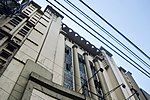Bahay Nakpil-Bautista
Bahay na batoBuildings and structures in Quiapo, ManilaCultural Properties of the Philippines in Metro ManilaHeritage Houses in the PhilippinesHouses in Metro Manila ... and 3 more
Museums in ManilaNational Historical Landmarks of the PhilippinesUse mdy dates from January 2022

The Nakpil-Bautista House (Tagalog: Bahay Nakpil-Bautista) is a bahay na bato ancestral home found in the district of Quiapo, Manila, the Philippines. It was built in 1914 by Arcadio Arellano. The house originally sat on two lots, having a total area of 500 square metres (5,400 sq ft). The National Historical Commission of the Philippines declared the house as a cultural property on August 25, 2011. Today, the house is a museum and community center showcasing items of the Katipunan, paintings, among others.
Excerpt from the Wikipedia article Bahay Nakpil-Bautista (License: CC BY-SA 3.0, Authors, Images).Bahay Nakpil-Bautista
A. Bautista Street, Manila Quiapo (Third District)
Geographical coordinates (GPS) Address External links Nearby Places Show on map
Geographical coordinates (GPS)
| Latitude | Longitude |
|---|---|
| N 14.598404 ° | E 120.984739 ° |
Address
Bahay Nakpil-Bautista
A. Bautista Street 432
1001 Manila, Quiapo (Third District)
Philippines
Open on Google Maps








